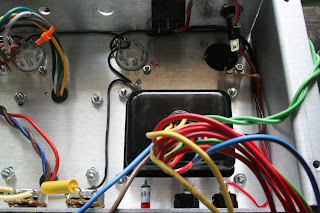The SE Electronics SE2200a has received a fair amount of attention in the past, especially for it's price to performance ratio (as if you can actually break down a microphone's performance into a numerical value), and my experience with the microphone has not been any different.
 |
| The SE Electronics SE2200a |
The SE2200a is quite an attractive microphone, covered in a brushed aluminum/champagne finish, adorned only by a small "SE" logo in red and inset "SE2200a" on the business end of the mic, lending the mic a clean and classy appearance. The microphone itself is of substantial weight, especially considering it being a solid state microphone; heavier than that of competitive microphones in it's class (AT4040, Rode NT1), giving a solid feel. The microphone too is supplied with a similarly finished shock mount which acts as a microphone stand adaptor. The combination of microphone and shock mount looks great on the mic stand; any engineer can present the microphone with confidence to any discerning vocalist or voice-over actor.
Features
Now microphones are simple machines by design, but the SE2200a has some great bells and whistles, despite the lower price point. First off was the included shock mount, which screws into the bottom of the microphone securely. The mic also has two switches, one a -10dB pad for using the microphone on loud sources (to keep the microphone's internal FET preamplifier from over loading), and a high pass filter with a gentle -12dB slope starting at 80Hz and extending below. Both of these features make the microphone more versatile in recording situations.
Most importantly for me is the inclusion of an output transformer. Many of the classic condenser microphones had output transformers, such as the Neumann U87 (solid state) and the AKG C12 (valve). Though transformer-less output microphones oftentimes boast better signal-to-noise and lower total harmonic distortion (THD) than that of a transformer-output microphone, I've always felt that an output transformer lends a bit more depth to the overall sonic image. The SE2200a is a solid state condenser microphone, utilizing a FET preamplifier circuit and an output transformer. Lastly, the SE2200a is a cardioid only design, so those searching for a multi-pattern condenser will have to search elsewhere.
 |
I bought this particular mic exclusively for vocal use, so that is where I used it right away. I tested it against the Audio Techinca AT2020 ($100 street), though the comparison isn't completely fair, due to differences in diaphragm size and price point. The AT2020 (review coming soon) is a great budget general-purpose cardioid-only condenser microphone which I have been able to use with great results on both instruments and vocals, so I though the comparison could be useful.
In comparison to the AT2020, the SE2200a yielded a deeper soundstage; my voice sounded more realistic, though the sound of the SE2200 was more flattering than neutral. The overall sound was warm, with a noticeable though not distracting bump centered around 250Hz that gradually tapered on either side. This would probably cause an issue with proximity effect, but the onboard high pass filter was useful for cutting down on the mud while still preserving the weight of the sound. The microphone also had a slight hump in the highs around 12kHz, lending airiness to the sound without harshness. This high end emphasis however should be minded, for singing directly into the microphone without proper distance can create sibilance issues for some singers. This goes as well for proximity effect.
For the particular song I sang to, I found the natural sound of the microphone needed very little mixing, especially when tracked with my ART Pro VLA II tube compressor in line. The vocal remained the center of attention without surging forward too far out of the mix and without taking over the mix completely. The vocal just seemed to find the right place in the mix once it was leveled in relation to the rest of the instruments: just what a good vocal microphone should do.
Just another note: the microphone was also noticeably more sensitive than the AT2020, picking up added room ambience. This can definitely be a good thing when recording in a suitable acoustic environment, but may require some extra treatments, such as a reflection filter or baffles to get the intended result from the vocal.
Conclusion
The SE Electronics SE2200a is definitely a good (maybe even great) microphone, especially considering it's price of around $250 USD. Prices aside, I believe the microphone to be a great vocal performer in general, adding weight and three-dimensionality to both lead and backing vocals, all without taking over the mix. The overall character of the mic was smooth and classic, up front without jumping out at the listener; in my mind, what a good transformer-output FET condenser should sound like.














